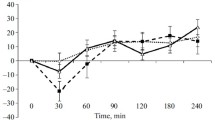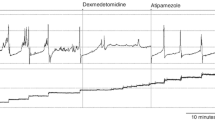Summary
Rats were injected subcutaneously (s.c.) with morphine (5mg/kg) until tolerance developed to its antinociceptive action, or with 0.9% saline which was used as vehicle for morphine. Subsequently, both groups of animals were given an intrathecal (i.th.) dose of either noradrenaline (2 μg), clonidine (12.5 μg) or guanfacine (12.5 μg), that had been found previously to be reliably antinociceptive. In the saline-treated animals, these doses of noradrenaline, clonidine or guanfacine induced clear antinociceptive effects, but not in the morphinegroup. It is therefore concluded that cross-tolerance to the antinociceptive effects of systemic morphine and the α-adrenoceptor agonists was obtained. The cross-tolerance between morphine on one hand, and noradrenaline, clonidine and guanfacine on the other, implies that a substantial opiate-adrenoceptor interaction exists in antinociceptive processes.
Similar content being viewed by others
References
Archer T, Danysz W, Jonsson G, Minor BG, Post C (1986) 5-Methoxy-N,N-dimethyl-tryptamine-induced analgesia is blocked by α-adrenoceptor antagonists in rats. Br J Pharmacol 89: 293–298
Bentley GA, Newton SH, Starr J (1983) Studies on the antinociceptive action of α-agonist drugs and their interaction with opioid mechanisms. Br J Pharmacol 79: 125–134
Berge O-G, Hole K (1981) Tolerance to the antinociceptive effect of morphine in the spinal rat. Neuropharmacology 20: 653–657
Calcutt CR, Handley SL, Sparkes CG, Spencer PSJ (1972) Roles of noradrenaline and 5-hydroxytryptamine in the antinociceptive affects of morphine. In: Kosterlitz HW, Collier HOJ, Villareal JE (eds) Agonist and antagonist actions of narcotic analgesic drugs. Macmillan, London, pp 176–191
Dahlström A, Fuxe K (1965) Evidence for the existence of monamine-containing neurons in the central nervous system. II. Experimentally induced changes in the intraneuronal amine levels of bulbospinal neuron systems. Acta Physiol Scand 64 [Suppl 247]: 1–36
Basbaum AI, Fields HL (1984) Endogenous pain control systems: brainstem spinal pathways and endorphin cicuitry. Ann Rev Neurosci 7: 309–338
Fitzgerald M (1986) Monoamines and descending control of nociception. Trends Neurosci 9: 51–52
Fleetwood-Walker SM, Mitchell R, Hope PJ, Molony V, Iggo A (1985) An α2 receptor mediates the selective inhibition by noradrenaline of nociceptive responses of identified dorsal horn neurones. Brain Res 334: 243–254
Hammond DL, Proudfit HK (1980) Effects of locus coeruleus lesions on morphine-induced antinociception. Brain Res 188: 79–91
Headley PM, Duggan AW, Griersmith BT (1978) Selective reduction by noradrenaline and 5-hydroxytryptamine of nociceptive responses of cat dorsal horn neurones. Brain Res 145: 185–189
Howe JR, Yaksh TL (1982) Changes in sensitivity to intrathecal norepinephrine and serotonin after 6-hydroxydopamine (6-OHDA), 5,6-dihydroxytryptamine (5,6-DHT) or repeated monoamine administration. J Pharmacol Exp Ther 220: 311–321
Jensen TS (1986) Endogenous antinociceptive systems: studies on spinal and supraspinal modulating mechanisms with particular reference to monoaminergic and opioid systems. Acta Neurol Scand 74 [Suppl 108]: 7–35
Jones SL, Gebhart GF (1986) Characterization of coeruleospinal inhibition of the nociceptive tail-flick reflex in the rat: mediation by spinal α2-adrenoceptors. Brain Res 364: 315–330
Kaneto H, Kihara T (1986) Morphine analgesia without development of tolerance in reserpinized mice. Jpn J Pharmacol 42: 169–173
Kayser V, Gilbaud G (1985) Can tolerance to morphine be induced in arthritic rats? Brain Res 334: 335–338
Kuraishi Y, Harada Y, Aratani S, Satoh M, Takagi H (1983) Separate involvement of the spinal noradrenergic and serotonergic systems in morphine analgesia: the differences in mechanical and thermal algesic tests. Brain Res 273: 245–252
Kuraishi Y, Hirota N, Satoh M, Takagi H (1985) Antinociceptive effects of intrathecal opioids, noradrenaline and serotonin in rats: mechanical and thermal algesic tests. Brain Res 326: 168–171
Milne B, Cervenko F, Jhamandas K, Loomis C, Sutak M (1985) Analgesia and tolerance to intrathecal morphine and norepinephrine infusion via implanted mini-osmotic pumps in the rat. Pain 22: 165–172
Ossipov MH, Chatterjee TK, Gebhart GJ (1985) Locus coeruleus lesions in the rat enhance the antinociceptive potency of centrally administered clonidine but not morphine. Brain Res 341: 320–330
Pang I-H, Vasko MR (1986) Effect of depletion of spinal cord norepinephrine on morphineinduced antinociception. Brain Res 371: 171–176
Pert CB, Pasternak GW, Snyder SH (1973) Opiate agonists and antagonists discriminated by receptor binding in brain. Science 182: 1359–1361
Post C, Arweström E, Minor BG, Wikberg JES, Jonsson G, Archer T (1985) Noradrenaline-depletion increases noradrenaline-induced antinociception in mice. Neuroscience Lett 59: 105–109
Reddy SVR, Maderdrut JL, Yaksh TL (1980) Spinal cord pharmacology of adrenergic agonist-mediated antinociception. J Pharmacol Exp Ther 213: 525–533
Rogers NF, El-Fakahany EE (1986) Morphine-induced receptor down-regulation detected in intact adult rat brain cells. Eur J Pharmacol 124: 221–230
Sharma SK, Nirenberg M, Klee WA (1975) Morphine receptors as regulators of adenylate cyclase activity. Proc Natl Acad Sci USA 75: 590–594
Siegel S (1956) Non-parametric statistics for the behavioral sciences. McGraw-Hill, New York
Taiwo YO, Fabian A, Pazoles CJ, Fields HL (1985) Potentiation of morphine antinociception by monoaminergic reuptake inhibitors in the rat spinal cord. Pain 21: 329–337
Tenen SS (1967) The effects of p-chlorophenylalanin, a serotonin depletor, on avoidance acquisition, pain sensitivity and behavior in the rat. Psychopharmacologia 10: 204–219
Unnerstall JR, Kopajtic TA, Kuhar MJ (1984) Distribution of α2-agonist binding sites in the rat and human central nervous system: analysis of some functional, anatomic correlates of the pharmacologic effects of clonidine and related adrenergic agents. Brain Res Rev 7: 69–101
Ventafridda V, Figliuzzi M, Tamburini M, Gori E, Parolaro D, Sala M (1979) Clinical observation on analgesia elicited by intrathecal morphine in cancer patients. In: Bonica JJ, Liebeskind JC, Albe-Fessard DG (eds) Advances in pain research and therapy, vol 3. Raven Press, New York, pp 559–565
Wang JK (1977) Antinociceptive effect of intrathecally administered serotonin. Anesthesiology 47: 269–271
Westlund KN, Bowker RM, Ziegler MG, Coulter JD (1984) Organization descending noradrenergic systems. In: Ziegler MG, Lake CR (eds) Norepinephrine (Frontiers of clinical neuroscience), vol 2. William and Wilkins, Baltimore, pp 55–73
Wiesenfeld Z, Gustafsson LL (1982) Continous intrathecal administration of morphine via an osmotic minipump in the rat. Brain Res 247: 195–197
Yaksh TL (1979) Direct evidence that spinal serotonin and noradrenaline terminals mediate the spinal antinociceptive effects of morphine in the periaqueductal gray. Brain Res 169: 180–185
Yaksh TL, Kohl RL, Rudy TA (1977) Induction of tolerance and withdrawal in rats receiving morphine in the spinal subarachnoid space. Eur J Pharmacol 42: 275–284
Yaksh TL, Noueihed R (1985) The physiology and pharmacology of spinal opiates. Ann Rev Pharmacol Toxicol 25: 433–462
Yaksh TL, Rudy TA (1976) Chronic catheterization of the spinal subarachnoid space. Physiol Behav 17: 1031–1036
Yaksh TL, Wilson PR (1979) Spinal serotonin terminal system mediates antinociception. J Pharmacol Exp Ther 208: 446–453
Zhong F-X, Ji X-Q, Tsou K (1985) Intrathecal DSP4 selectively depletes spinal noradrenaline and attenuates morphine analgesia. Eur J Pharmacol 116: 327–330
Author information
Authors and Affiliations
Rights and permissions
About this article
Cite this article
Post, C., Archer, T. & Minor, B.G. Evidence for crosstolerance to the analgesic effects between morphine and selective α2-adrenoceptor agonists. J. Neural Transmission 72, 1–9 (1988). https://doi.org/10.1007/BF01244627
Received:
Accepted:
Issue Date:
DOI: https://doi.org/10.1007/BF01244627




